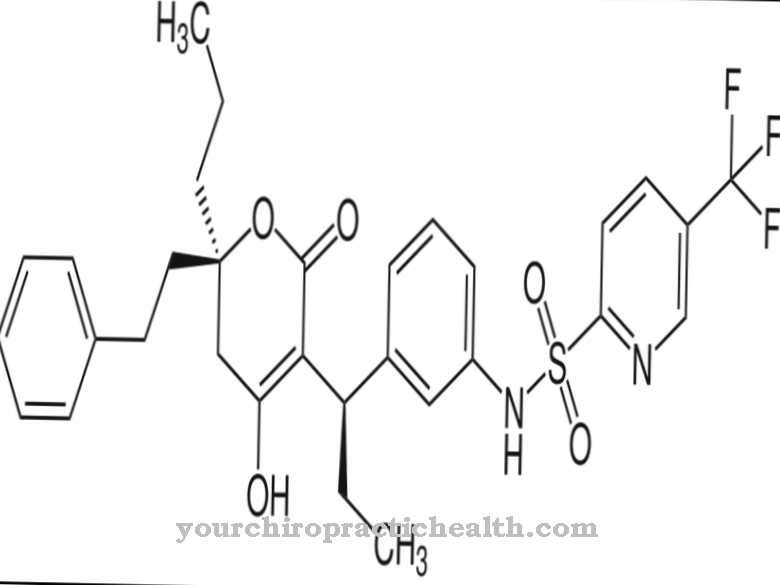Pipamperon is an antipsychotic from the group of butyrophenones. It has a sedating effect and is one of the low-potency neuroleptics (antipsychotics).
What is pipamperon?

Pipamperon is also called Dipiperone or Floropipamide designated. It is a drug from the class of antipsychotics. Just like haloperidol or benperidol, pipamperon belongs to the butyrophenones. Butyrophenones are drugs that are derived from 1-phenylbutan-1-one. They are preferred for the treatment of schizophrenia in psychiatric facilities.
Pipamperon is one of the kidney-potent neuroleptics. Compared to the highly potent drugs from the group of antipsychotics, the effect of pipamperon is rather mild. The tolerance is proportionate, so that the drug is also used in child and adolescent psychiatry.
Pharmacological effect
Various messenger substances serve to transmit signals in the body. The messenger substances of the brain and the nervous system are called neurotransmitters. An imbalance in neurotransmitters can lead to mental illness. The neurotransmitters dopamine and serotonin are particularly often involved.
Pipamperon mainly blocks the effects of dopamine. It binds to D2 and D4 receptors and thus prevents dopamine from docking with these receptors. Pipamperon thus has an antidopaminergic effect. On the psychotropic level, dopamine increases drive and motivates. However, excessively high dopamine levels are suspected of triggering schizophrenia.
Pipamperon not only blocks the dopamine but also the serotonin receptors. It has an antipsychotic, calming and arousal-suppressing effect. A sleep-promoting effect can also be observed.
In contrast to other neuroleptics, pipamperon is hardly anticholinergic, which means that it does not inhibit the neurotransmitter acetylcholine. The histamine 1 receptors are also not affected.
The half-life of pipamperon in the blood is 16 to 22 hours. The drug is broken down again via N-dealkylation and oxidation.
Medical application & use
Pipamperon is used to treat anxiety, sleep disorders, and mood swings. It should have a regulating effect on the neurotransmitter balance and promote sleep. Pipamperon is also said to reduce states of excitement and aggressiveness.
The drug is primarily prescribed as a light sleep aid. However, in the elderly and in people with mental illness, pipamperon is also used as a sedative. Pipamperon is mainly used in children to reduce aggressiveness. In Switzerland, the drug is also approved for the treatment of chronic psychoses.
The dosage is always adjusted individually by the specialist. The drug is crept in for better tolerability. It can be taken independently of meals.
You can find your medication here
➔ Medicines to calm down and strengthen nervesRisks & side effects
Compared to other neuroleptics, Pipamperon is relatively well tolerated. There are no anticholinergic side effects, but higher doses can lead to extrapyramidal motor disorders. The movement disorders mainly show up in the face. Typical are throat cramps and the so-called "rabbit syndrome". The involuntary mumming of the patient is reminiscent of the mumming of a rabbit. Sitting restlessness, twitching, grimacing and involuntary movements of the extremities can also occur.
Neuroleptic malignant syndrome can occur in very rare cases. It manifests itself through akinesia, extreme muscle stiffness, hyperthermia with profuse sweating, jaw clamp, mutism, confusion and disturbances of consciousness up to coma. The malignant neuroleptic syndrome can be fatal and is therefore a dreaded complication of neuroleptic therapy.
More often, patients experience loss of appetite, nausea, or vomiting while taking it. The effect on the endocrine system can lead to hyperprolactinemia. The result is breast enlargement and menstrual disorders.
At the cardiovascular level, the heart rate can be accelerated and the blood pressure too low. Cardiac arrhythmias occur very rarely. Since Pipamperon can lengthen the QT interval, it should not be combined with other active substances that also cause a lengthening of the QT interval. These include, for example, diuretics.
Centrally depressant drugs such as sleeping pills, antidepressants, opioids or even alcohol can increase the sedative effect of Pipamperon. If Pipamperon is given in combination with antihypertensive drugs, the blood pressure can drop sharply.
The combination of pipamperon with dopamine antagonists such as lisuride, bromocriptine or levodopa is also not recommended. In addition, Pipamperon should not be administered with drugs that lower the brain's seizure threshold. Otherwise epileptic seizures could occur.
























.jpg)



